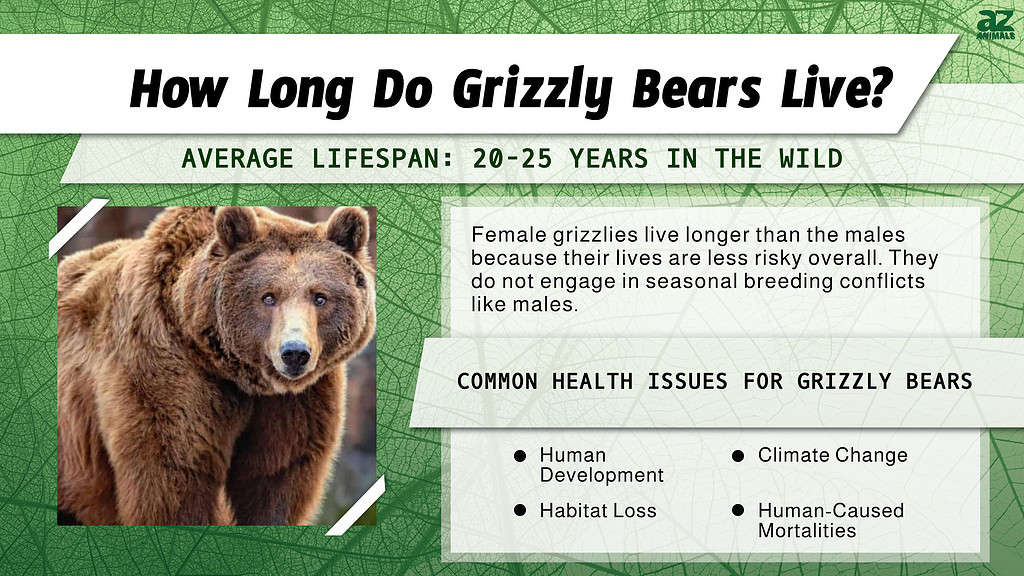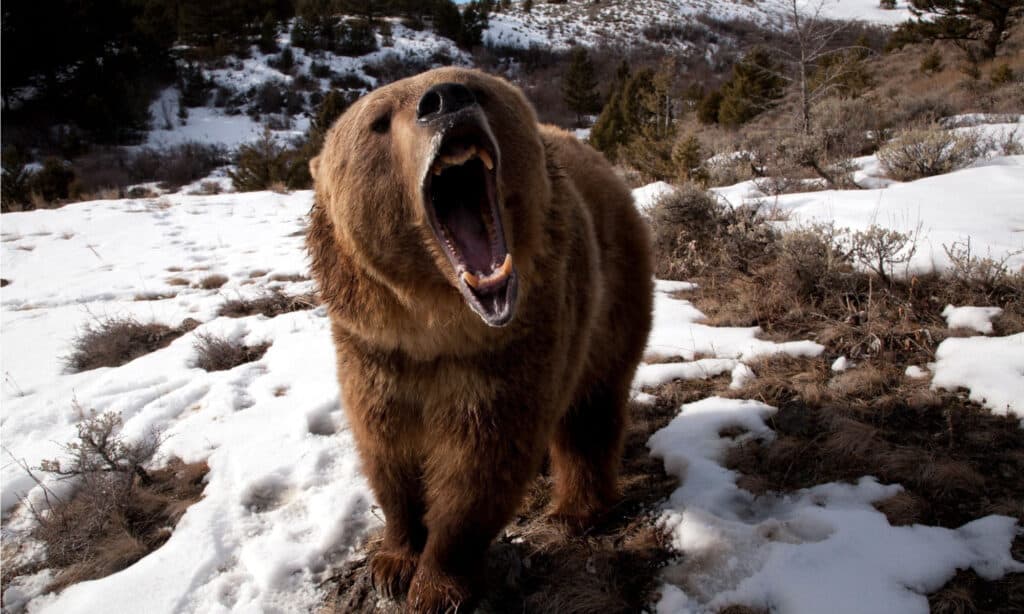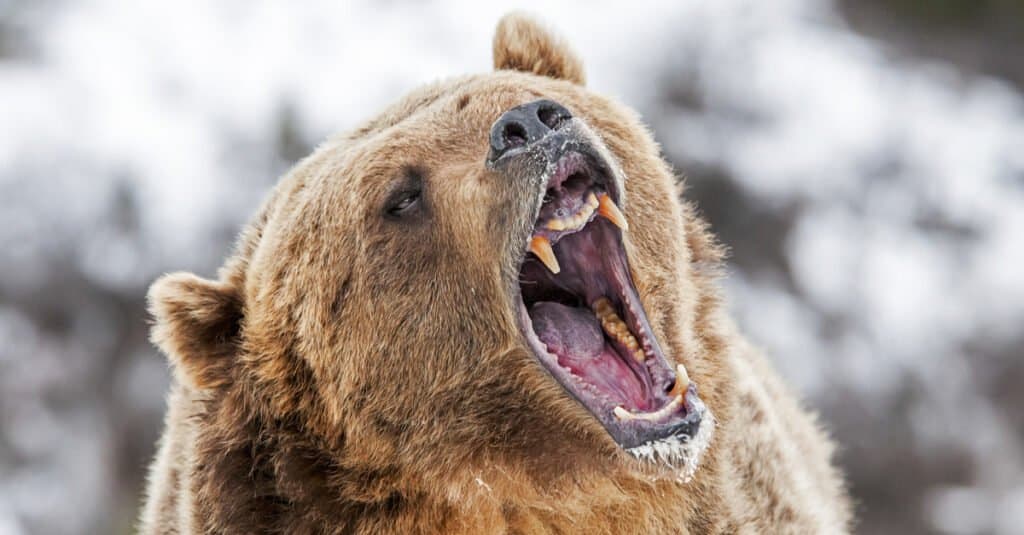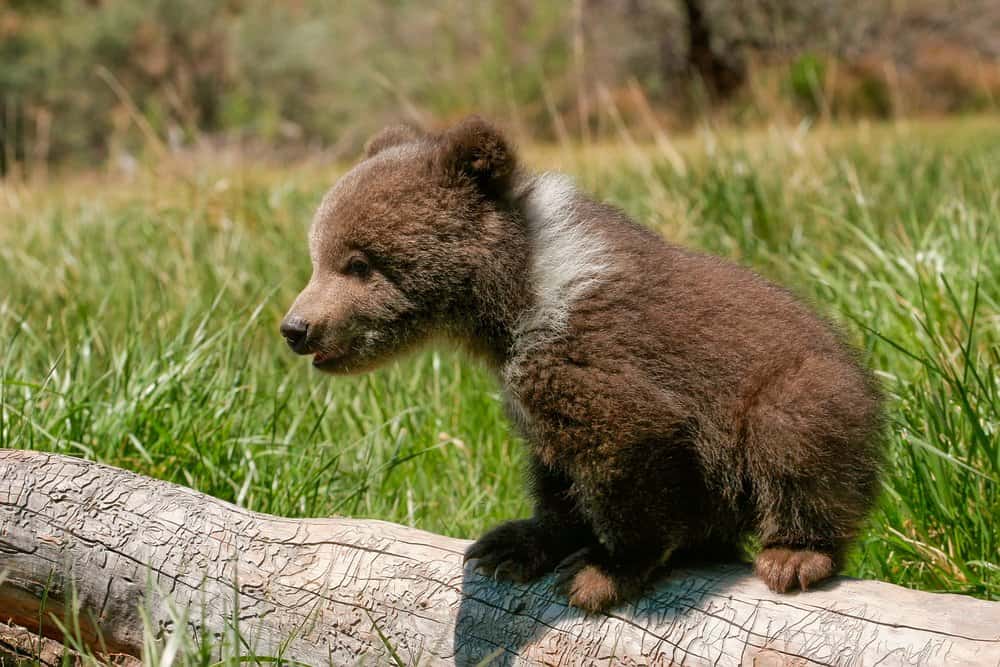
Grizzly bears are inland Northern American subspecies of the brown bear. They are well-known for their massive size (up to 360kg) and frequently violent attitude. Hence the name, grizzly bear. As young children, many of us grew up either incredibly fascinated or frightened of the massiveness of the grizzly bear.
But how well do you know this intriguing king of the food chain? We’ve got the rundown on all the facts, including the grizzly bear lifespan and more. With these astonishing facts, you may discover their distinct and adventurous world!
Quick Crash Course On Grizzly Bears

Grizzly bears can consume up to 90 pounds of food each day.
©Falade Adewale/Shutterstock.com
Grizzly bears are classified as a subspecies of brown bears. The primary distinction between them is based on nutrition and environment. Brown bears reside mostly along the coast and have access to marine meals, whereas grizzlies inhabit further inland in wooded areas. Their hair is weathered, which means it has silver tips. However, it is thought that they were named after the term “grisly,” which means “gruesome or frightening.”
Grizzly bears are apex predators. This indicates that they are at the top of the food chain. They use their speed and power to catch huge creatures like moose, caribou, and bison. When you consider their sheer size, it makes sense just how scary these big bears can be! Grizzly bears are around two meters (six feet) long on average, with females averaging 130-180kg (286-396lbs) and males 180-360kg (396-793lbs). This is definitely not the type of animal you want to catch on a bad day!
Now that we have a better grasp of this magnificent hunter, let’s look at the grizzly bear lifespan.
How Long Do Grizzly Bears Live?

Grizzly bears live around 20-25 years in the wild and 44 years in captivity.
©Scott E Read/Shutterstock.com
The average grizzly bear’s lifespan is 20-25 years in the wild. Captive grizzlies can live for up to 44 years.
A male’s average lifespan is believed to be 22 years, while a female’s average lifespan is somewhat longer at 26 years. The female grizzlies live longer than the males because their lives are less risky overall. They do not engage in seasonal breeding conflicts like males.
In Alaska, the oldest known wild inland grizzly was roughly 34 years old. However, the majority of grizzlies will die during their first year of life.
A study published in the Journal Of Wildlife Management sought to uncover Grizzly Bear Demographics In And Around Banff National Park And Kananaskis Country, Alberta. The region around Banff National Park (BNP) in southern Alberta, Canada, is one of the most highly utilized and developed locations where grizzly bears may still be found.
From 1994 to 2002, 37 female and 34 male bears were radiomarked and monitored in this area to estimate rates of survival, reproduction, and population growth. The females had an annual survival rate of 95 percent, while the males had an annual survival rate of 81–85 percent. Although hunters were generally inactive in this region, humans still caused 75% of the female deaths and 86% of the male deaths.
Now that we’ve learned everything there is to know about the grizzly bear lifespan, let’s have a look at their fascinating life cycle.
The Average Grizzly Bear Life Cycle
It is absolutely crazy to think about how grizzly bears go from small helpless cubs to feared and strong predators that can knock down massive animals. If you’re curious to find out how this happens, we’ve got the details on it all.
Breeding
The mating season for most grizzly bears lasts from May until the beginning of June. Between the ages of 4.5 and 10 years, the females reach sexual maturity and are ready to have cubs. Because it takes a few years to integrate their cubs into the world, most females will only reproduce once every three to four years.
Gestation
The bear gestation period ranges from 180 to 266 days. The fetus’s growth is briefly halted while the female gorges herself on whatever meals are available during the summer and fall in order to create a layer of fat to survive the winter months. She will then pick a location for her den and enter a hibernation state. Once she reaches this stage, the embryo begins to grow again, and the mother gives birth to one to four cubs no later than March.
Cubs
Baby grizzly bears are called cubs. The newborn cub has no fur and cannot see until it is a few days old. The cubs are still bonded to their mothers until they reach the age of around three years old. During this time, it is the mother bear’s job to keep her cubs safe from predators until they are old enough to defend themselves.
Adult
When the cubs are old enough to fend for themselves, the mother will turn them away from her and begin breeding again. By this period, the young grizzly bears weigh between 350 and 700 pounds, which is comparable to the weight of a fully grown grizzly bear. They will continue to grow and hunt and eventually breed from this point on.
What Factors Impact The Grizzly Bear Lifespan

Conflict with people is one of the most serious dangers to grizzly bear populations.
©Don Mammoser/Shutterstock.com
Grizzly bears are a significant icon of the wilderness. Since they reproduce quite slowly, it is easy for their population numbers to become negatively impacted.
Some factors that threaten the grizzly bear’s lifespan include:
- Human interactions: Human-caused mortality is the most common cause of death for grizzlies, and it is one of the primary causes restricting grizzly bear numbers. Human development has pushed grizzly bears out of half of their original range.
- Climate change: Global warming appears to be aggravating grizzly bear deaths caused by humans. Because of global warming, grizzly bears are denning later in the fall. This exposes them to human-caused mortality for additional several weeks during a period of the year when grizzlies and hunters coexist. Grizzly fatalities as a consequence of human self-defense are common.
- Habitat loss: Habitat loss is often considered the most urgent and serious threat to wildlife. The loss not only puts pressure on bear populations by lowering their potential ranges but also draws bears closer to human settlements and into farming areas.
The photo featured at the top of this post is © Scott E Read/Shutterstock.com
Thank you for reading! Have some feedback for us? Contact the AZ Animals editorial team.







